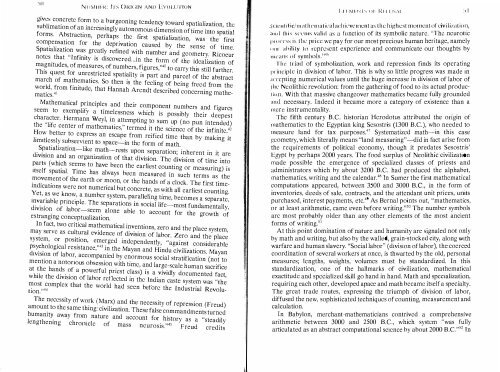CONTENTS - ouroboros ponderosa
CONTENTS - ouroboros ponderosa
CONTENTS - ouroboros ponderosa
You also want an ePaper? Increase the reach of your titles
YUMPU automatically turns print PDFs into web optimized ePapers that Google loves.
N(IlIH'IC ITS O/{J( ilN ANI) EV()UJTI()N<br />
gives concrete form to a burgeoning tendency toward spatialization, the<br />
sublimation of an increasingly autonomous dimension of time into spatial<br />
forms, Abstraction, perhaps the tlrst spatialization, was the first<br />
compensation tor the deprivation caused by tbe sense of time,<br />
Spatialization was greatly rehned with number and geometry, Ricoeur<br />
notes that "Infinity is discovered"jn the form of the idealization of<br />
magnitudes, of measures, of numbers, figures,"" to carry this still further.<br />
This quest for unrestricted spatiality is part and parcel of the abstract<br />
march of mathematics, So then is the feeling of being treed from the<br />
world, from finitude, that Hannah Arendt described concerning mathe<br />
matics.4l<br />
Mathematical principles and their component numbers and figurcs<br />
seem to exemplify a timelessncss which is possibly their deepest<br />
character. Hermann Weyl, in attempting to sum up (no pun intended)<br />
the "life center of mathematics," termed it the science of the infinite."<br />
How better to express an escape from reified time than by making it<br />
hmltlessly subservIent to space-in the form of math.<br />
Spatialization-like math-rests upon separation; inherent in it arc<br />
division and an organization of that division. The division of time into<br />
parts (whi h seems to have been the earliest counting or measuring) is<br />
Itself spattal. TIme has always been measured in such terms as the<br />
movement of the earth or moon, or the hands of a clock. The first time<br />
indications were not numerical but concrete, as with all earliest counting.<br />
Yet, as we know, a number system, paralleling time, becomes a separate,<br />
mvanable pnnclple. The separations in social life-most fundamentally,<br />
dIvIsIon ot labor-seem alone able to account for the growth of<br />
estranging conceptualization.<br />
In fact, two critical mathematical inventions, zero and the place system,<br />
may serve as cultural evidence of division of labor. Zero and the place<br />
system, or position, emerged independently, "against considerable<br />
psy hological resistance,"" in the Mayan and Hindu civilizations. Mayan<br />
dIVISIon of labor, accompanied by enormous social stratification (not to<br />
mention a notofloUS obsession with time, and large-scale human sacrifice<br />
at the hands of a powerful priest class) is a vividly documented fact,<br />
while the division of labor reflected in the Indian caste system was "the<br />
most complex that the world had seen betore the Industrial Revolu<br />
tion. ,,44<br />
The necessity of work (Marx) and the necessity of repression (Freud)<br />
amount to the same thing: civilization. These false commandments turned<br />
humanity . away from nature and account for history as a "steadily<br />
lengthenmg chroillcle of mass neurosis."" Freud credits<br />
l'I I'l\lI'N I'l Ill, 1':'1-1 1 1\.\(<br />
Sell;: 1l11fic/lll;1I he ilia I ll'a l ae hicve Illen t as t he highest mOlllcn t of. eiv ili/.at iUl?,<br />
a1Ld this Sl'eIllS valid as a funct io n of its symholic nature. " he neurotic<br />
1 11 1 It-l"SS is tile price we pay for our most precious h <br />
man hentage, namely<br />
(HII' ;lhility to represent experience and commumcate our thoughts by<br />
I· l l , ,, 46<br />
IIwallS () sym 10 S.<br />
. . ' . ,<br />
Till' triad of symbolization, work and repressIOn fmds Its opcratlllg<br />
I " illeipIc in division of labor. This is why so little progress was made m<br />
.[('cepling numerical values until the huge mcrease III dIVISIon of labor of<br />
Iile Neolithic revolution: from the gathering of food to Its actual produc-<br />
111lIJ. With that massive changeover mathematics became tully grounded<br />
"11(1 necessary. Indeed it became more a category of eXIstence than a<br />
mere instrumentality.<br />
. . .<br />
The fifth century B.C. historian Herodotus attributed the ongm of<br />
mathematics to the Egyptian king Sesostris (1300 B.C.), who needed to<br />
measure land for tax purposes.47 Systematized math-m<br />
thIS case<br />
.<br />
geometry, which literally means "land measuring"- did in fact anse fro<br />
.<br />
the requirements of political economy, though t predates Sesostns<br />
C!,'ypt by perhaps 2000 years. The food surplus at NeolithIC CIVIlizatIOn<br />
made possible the emergence of specialized classes of pnests and<br />
administrators which by about 3200 B.C. had produced the alphabet,<br />
mathematics writing and the calendar." In Sumer the first mathematical<br />
computation appeared, between 3500 and 3000 B.c., in the form of<br />
inventories<br />
'<br />
deeds of sale, contracts, and the attendant umt pnces, UilltS<br />
purchased, interest payments, etc.49 As Bernal points out, "mathematIcs,<br />
or at least arithmetic, came even before writing."so The number symbols<br />
arc most probably older than any other elements of the most ancIent<br />
forms of writing 51<br />
. .<br />
At this point domination of nature and humaillty are SIgnaled not only<br />
by math and writing, but also by the wall, gr in-stocked CIty, along WIth<br />
warfare and human slavcry. "Social labor (dIvIsIon ot labor), the coerced<br />
coordination of several workers at once, is thwarted by the . old, person l<br />
measures; lengths, weights, volumes must be standardIzed. In thIS<br />
standardization, one of the hallmarks of civilization, mathematIcal<br />
exactitude and specialized skill go hand in hand. Math and speCializatIOn,<br />
requiring each other, developed apace and math becamc ltselt a speCIalty.<br />
The great trade routes, expressing the triumph of dIVISIon of labor,<br />
diffused the new, sophisticated techniques of counting, measurement and<br />
calculation.<br />
.<br />
In Babylon, merchant-mathematicians contrived a comprehenSIve<br />
arithmetic between 3000 and 2500 B.C., which system "was ,,;lly<br />
articulated as an abstract computational sCIence by about 2000 B.C. In






